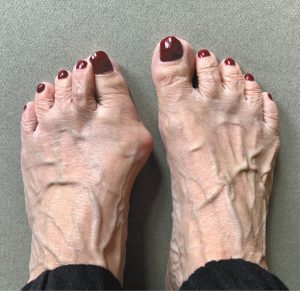Michael J. Petrocelli, D.P.M., F.A.C.F.A.S., C.W.S.P.
Board Certified Ankle and Foot Surgeon and Board Certified Wound Care Specialist


Bunions, medically known as Hallux Valgus, manifest as a bony bump at the base of the big toe. They develop when the joint at the base of the big toe shifts out of place, causing the big toe to lean toward the second toe. This misalignment can lead to pain, inflammation, and difficulty finding comfortable footwear.
One primary cause of bunions is wearing ill-fitting shoes, especially those with a narrow toe box. Genetics also play a role; if bunions run in your family, you might be more prone to developing them. Additionally, conditions like arthritis and foot injuries can contribute to bunion formation.
For those experiencing bunion-related discomfort, consulting a podiatrist is crucial. A podiatrist can assess the severity of the condition and recommend appropriate treatment options. Here are some common strategies podiatrists employ to address bunions:
Footwear Modifications: Wearing shoes with a wider toe box and low heels can help reduce pressure on the affected area. Podiatrists often advise against high heels or shoes that squeeze the toes, as these can exacerbate bunion symptoms.
Orthotic Devices: Custom orthotic inserts can provide additional support and help distribute pressure more evenly across the foot. Podiatrists may recommend off-the-shelf or custom-made orthotics based on the patient’s specific needs.
Padding and Taping: Applying pads or moleskin to the bunion can alleviate friction and reduce pain. Taping techniques may also be employed to help realign the big toe and relieve pressure on the bunion.
Physical Therapy: At times Physical Therapist are implemented as part of the post operative bunionectomy recovery to facilitate better range of motion in the joint. This is especially important for not all bunion surgeries are the same. Some include correction of the soft tissue, bone, or both, and the postoperative course and rehab depends on the type of surgery and exercise modification to be implemented.
Medications: Nonsteroidal anti-inflammatory drugs (NSAIDs) can help manage pain and reduce inflammation associated with bunions. However, long-term use should be monitored by a healthcare professional.
Bunion Splints: Splints or braces designed to hold the big toe in a corrected position may be recommended, particularly during sleep. These devices can help slow the progression of the bunion.
Injections: In some cases, corticosteroid injections may be administered to alleviate severe pain and inflammation. This is a short-term solution and is typically used when other conservative measures are insufficient.
Surgical Intervention: When conservative treatments fail to provide relief, surgical intervention may be considered. A podiatrist can discuss surgical options, such as bunionectomy, to realign the affected joint and alleviate pain.
It’s essential for individuals with bunions to address the condition promptly to prevent worsening symptoms. Regular check-ups with a podiatrist, along with proactive measures like choosing appropriate footwear and maintaining a healthy weight, can contribute to better bunion management.
In conclusion, bunions are a common foot condition that can impact daily life, but with the guidance of a podiatrist, effective treatment options are available. Whether through conservative measures or surgical intervention, addressing bunions promptly can lead to improved comfort and mobility. If you’re experiencing bunion-related discomfort, don’t hesitate to seek professional advice and take steps toward better foot health.
Collier Podiatry
It’s important to be evaluated by an experienced podiatric professional if you’re experiencing any type of foot pain. At Collier Podiatry, Dr. Michael Petrocelli has been practicing podiatric medicine for well over 29 years. He is an expert in his field and a leader to his peers, he and his staff see a countless number of patients with bunion pain in the Naples area.
Along with bunion treatment, Collier Podiatry will provide you with personalized instructions on the necessary amount of rest, stretching exercises and home care to get you back to doing what you love.
Please call Collier Podiatry, P.A. today if you are suffering from bunions to discuss the treatment you need to relieve the pain and correct deformities!
Collier Podiatry, P.A.
Michael J. Petrocelli
D.P.M., F.A.C.F.A.S., C.W.S.P.
239-775-0019
www.collierpodiatry.com
NCH Countryside Commons
1715 Heritage Trail, Suite 204
Naples, FL 34112
Phone: (239) 775-0019
Fax: (239) 775-0219
 Southwest Florida's Health and Wellness Magazine Health and Wellness Articles
Southwest Florida's Health and Wellness Magazine Health and Wellness Articles
